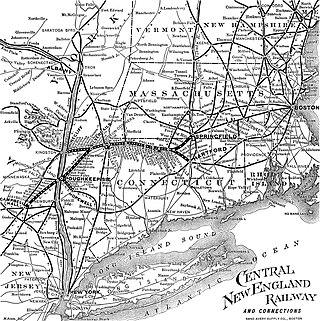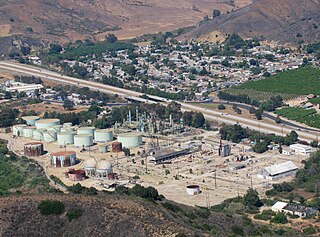Related Research Articles

Boise City is a city in and the county seat of Cimarron County, in the Panhandle of Oklahoma, United States. The population was 1,166 at the 2020 census, a decline of 7.9 percent from 1,266 in 2010.
Coyle is a town in Logan County, Oklahoma, United States. The population was 325 at the 2010 census, compared to the figure of 337 in 2000. It is part of the Oklahoma City metropolitan area. The town was named for William Coyle, an influential Guthrie business man.

Cushing is a city in Payne County, Oklahoma, United States. The population was 7,826 at the time of the 2010 census, a decline of 6.5% since 8,371 in 2000. Cushing was established after the Land Run of 1891 by William "Billy Rae" Little. It was named for Marshall Cushing, private secretary to U.S. Postmaster General John Wanamaker.

Drumright is a city in Creek and Payne counties in the U.S. state of Oklahoma. It began as an oil boom town. However, the population has declined as oil production has waned in the area. The population was 2,907 at the 2010 census, a figure almost unchanged from 2,905 in 2000. Drumright and nearby Cushing were at the center of the large, productive Cushing-Drumright Oil Field in the 1910s and 1920s. Now Drumright is home to a festival called The Drumright Monthly Market, where hundreds of visitors come, seeking crafts and delicacies from all over the region. First Saturday of every month.

South Central Florida Express, Inc. is a common carrier shortline railroad in southern Florida run by U.S. Sugar Corporation. Its trains operate from Sebring to Fort Pierce via Clewiston around the southern perimeter of Lake Okeechobee, and serves customers at 26 locations. With 171 miles (275 km) of track, the SCXF is the largest private agricultural railroad in the U.S.

The Central New England Railway was a railroad from Hartford, Connecticut, and Springfield, Massachusetts, west across northern Connecticut and across the Hudson River on the Poughkeepsie Bridge to Maybrook, New York. It was part of the Poughkeepsie Bridge Route, an alliance between railroads for a passenger route from Washington to Boston, and was acquired by the New York, New Haven & Hartford Railroad in 1904.

The Lehigh and Hudson River Railway (L&HR) was the smallest of the six railroads that were merged into Conrail in 1976. It was a bridge line running northeast–southwest across northwestern New Jersey, connecting the line to the Poughkeepsie Bridge at Maybrook, New York with Easton, Pennsylvania, where it interchanged with various other companies.

The Northwestern Pacific Railroad is a regional shortline railroad utilizing a 62 mi (100 km) stretch of the 271 mile mainline between Schellville and Windsor with freight and Sonoma–Marin Area Rail Transit (SMART) commuter trains. Formerly, it was a regional railroad primarily used for logging that served the entire North Coast of California, with a main line running 271 miles (436 km) from Schellville to Eureka, along with an additional portion of the line running from the Ignacio Wye to the edge of San Rafael. The "Southern End" of the line, including Schellville to Willits and from Ignacio to San Rafael is owned by SMART, while the "Northern End" was formally owned and managed by the now-dissolved North Coast Railroad Authority but is now saved for use in California's 2018 Great Redwood Trail Act, which repurposes the unused railroad right-of-way from Eureka to Willits for future use as the Great Redwood Trail.

The Arkansas–Oklahoma Railroad is a Class III carrier headquartered in Wilburton, OK that operates two segments of the former Chicago, Rock Island and Pacific Railroad (CRIP) Choctaw Route that originally ran between Memphis Tennessee and Tucumcari, New Mexico. AOK started operations on March 3, 1996 on 73 miles of track then owned by the U.S. state of Oklahoma between Howe and McAlester by assuming the existing lease of the Missouri Pacific, then wholly owned by the Union Pacific Railroad (UP). This lease included a purchase option which was exercised by AOK in April 2016. The line interchanges with the Kansas City Southern Railway at Howe, and with the UP at McAlester.

Oklahoma City Union Depot is a building in Oklahoma City, Oklahoma that served as a "union station" from 1931 until 1967. It was listed on the National Register of Historic Places in 1979. It now houses the offices of the Scissortail Park Foundation.

The Gulf, Colorado and Santa Fe Railway was a subsidiary of the Atchison, Topeka & Santa Fe Railway. From its starting point in Galveston, Texas, the railroad eventually extended northwestwards across the state to Sweetwater and northwards via Fort Worth to Purcell, Oklahoma.
The Arkansas Valley and Western Railway (AV&W) was built as a short line railroad operating within the U.S. state of Oklahoma. It was founded in 1902 to link the city of Tulsa with the main transcontinental line of the Atchison, Topeka and Santa Fe Railway (AT&SF) at Avard. The line was built in sections, initially from AV&W Jct. to Steen (Enid) during 1902-03. In 1904 it was extended westward to the junction with AT&SF at Avard. On July 19, 1907, the railroad was purchased by the St. Louis-San Francisco Railway, who operated it until November 21, 1980, when the Frisco was acquired by Burlington Northern Railroad.
The Denver, Enid and Gulf Railroad (DE&G) was built as a short line railroad operating in Kansas, and Oklahoma. Incorporated in Oklahoma as the Denver, Enid and Gulf Railroad Company, March 31, 1902, by the five Frantz Brothers.
The Choctaw, Oklahoma and Gulf Railroad (CO&G), known informally as the "Choctaw Route," was an American railroad in the states of Arkansas and Oklahoma.

Morristown & Erie Railway is a short-line railroad based in Morristown, New Jersey, chartered in 1895 as the Whippany River Railroad. It operates freight rail service in Morris County, New Jersey and surrounding areas on the original Whippany Line between Morristown and Roseland, as well as the Morris County-owned Dover & Rockaway Branch, Chester Branch, and High Bridge Branch. The M&E also operated the Maine Eastern Railroad from November 2003 to December 31, 2015.

The Ventura and Ojai Valley Railroad gave Ojai, California, a connection to the national rail network Pacific Coast Line at Ventura Junction. Ventura Junction was located at Southern Pacific Railroad milepost (MP) 397.3 a short distance west of Ventura station. The railway required grades as steep as three percent following the Ventura River upstream through Chrisman, Wadstrom, Ortonville, and then turning east through Mira Monte into Ojai. The line completed by Captain John Cross in 1898 became a branch of the Southern Pacific Railroad in 1899. The first passenger train reached Ojai on 12 March 1898. Trains leaving Ojai at 07:20 and 16:00 made passenger stops at Grant, Tico, Las Cross, and Weldons before turning around at Ventura to return to Ojai at 13:00 and 20:15. Southern Pacific operated only one daily passenger train during the summer months; and all passenger service ended in the early 1930s.
The Buffalo and Northwestern Railroad was a railway extending from Waynoka, Oklahoma to Buffalo, Oklahoma, passing through Freedom, Oklahoma. About 52 miles in length, the line was completed in May, 1920 and sold to another railroad in June, 1920.
The Eastern Oklahoma Railway was incorporated under the laws of Oklahoma Territory on July 24, 1899. The railroad constructed much of its own track. This included Guthrie junction to Cushing junction, 47.9 miles, in the 1900-1902 timeframe; Ripley to Esau Junction, 40.4 miles, also in the 1900-1902 timeframe; Newkirk to Pauls Valley, 182.5 miles, in the 1900-1904 timeframe; and, Davis to Sulphur, 9.3 miles, in 1906.
The Oil Fields and Santa Fe Railway was an Atchison, Topeka and Santa Fe Railway ("AT&SF") subsidiary. It owned trackage in and about the Cushing-Drumright Oil Field in Oklahoma, and was leased to and operated by the AT&SF from its inception in the 1915-1916 timeframe until its merger into the AT&SF in 1941. All of its tracks were abandoned by 1963.
The White and Black River Valley Railway (“W&BRV”), previously called the Batesville and Brinkley Railroad (“B&B”), had a line between the towns of Brinkley and Jacksonport, as well as a branch line between Wiville and Gregory, entirely within the State of Arkansas and about 62 miles in total length. Its predecessor railroad was started in 1879, and the final portion of the line was closed in 1941. The railroad began as a narrow-gauge railway which was modified to become even narrower, but later converted to standard gauge. It was operated under lease by other railroads for much of its lifespan.
References
- ↑ "Railroad Reporting Marks-Past and Present". Piedmont and Western Railroad Clug. Retrieved March 15, 2023.
- ↑ "Hudson Refinery, Cushing, OK". United States Environmental Protection Agency. Retrieved March 15, 2023.
- 1 2 "Camp to Cushing, OK". AbandonedRails.com. Retrieved March 16, 2023.
- 1 2 3 4 "Cimarron River Valley Railway Company Employer Status" (PDF). Railroad Retirement Board (accessed on GovInfo.gov website). Retrieved March 16, 2023.
- 1 2 3 "Cushing's Fighting". The Dispatcher, January 1984 (accessed on Oklahoma Digital Prairie). Retrieved March 15, 2023.
- ↑ "Cimarron River Valley Railway Company". Oklahoma Secretary of State. Retrieved March 15, 2023.
- ↑ "Cimmaron River Valley Railroad-CVRL". TrainWeb.org. Retrieved March 16, 2023.
- ↑ Lewis, Edward A. (1996). Cimarron River Valley Railway. ISBN 9780890242902 . Retrieved March 16, 2023.
- ↑ "Oklahoma 2018-2020 State Railroad Map" (PDF). Oklahoma Department of Transportation. Retrieved March 15, 2023.